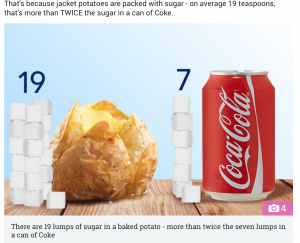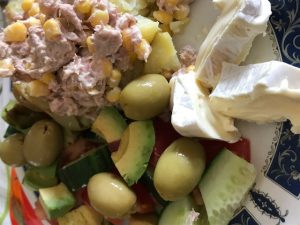So the news on the street is a jacket potato contains 19 sugar cubes. More than a can of coke. Now whilst this may be true on the one level there is a lot more going on here than just the sugar and it is not to say you cannot eat a baked spud.

Sugar in food is modified by several factors it is not something that can just be measured by sugar lumps alone. That potato has fibre, potassium (more than a banana), B6 and Vitamin C for starters. The can of coke – well I don’t think we can claim that has much else.
There is a system that ranks the effects that feeds have on blood sugars. This is the glycaemic index (GI), it looks at how rapidly a carbohydrate is digested and released as glucose into the blood stream. A food with a high GI food is one that increases the blood sugars faster, leading to a potential blood sugar spike. Using this ranking a jacket potato would be high (85) and something like chickpeas would be low (28). This is a really useful system but it has it flaws. If you use it alone you could live off chocolate and ice-cream as these are low GI! Also this system does not account for the carbohydrate in food and it uses 100 g of food, rather than looking at portion sizes. However it is still a useful way to compare foods and I’d highly recommend you focus on eating more low GI foods. But remember we do not eat these foods in 100g servings or in isolation. Read on to hear more about this.
You can download the British Dietetic Association Fact Sheet on GI here.
Another good ranking system for those concerned about blood sugar control is glycaemic load. This looks at the effect of food per portion and it does take into account carbohydrates. So for example foods that have a glycaemic index of less than 10 have a low or little impact on bloodsugars, GL of 10 to 20 is moderate and 20+ is high. Again another useful system to keep in mind, but it has it’s flaws (doesn’t everything!). We don’t eat these foods in isolation, so other factors come into play.
So let’s think about the nutrients and factors that affect glycaemic index and glycaemic load…
These are general rules, there are always exceptions:
1. Fibre is something that slows the rate of digestion and therefore stops blood sugars from increasing as fast.
2. Protein also has this effect on the body a food that is higher in protein will be a food that doesn’t increase your blood sugar as fast.
3. Fat also slows down the rate at which sugar enters the bloodstream, that is why something like chocolate may seem like it will be a food that will increase your bloodsugars fast, but actually that’s not always the case as the fat slows down the digestion.
4. Cooking method and processing also affect food, as does the variety of the food. For example, the impact on bloodsugars from a ripe banana will be much higher than in unripe one and it’s the same with a potato. With our baked potato the impact on bloodsugars is higher than when you eat new boiled potato or sweet potato.
Now this is where it gets complicated because we can’t just rank certain foods as good and others as bad! So where to go from here? Well these systems of GI/GL give us really good principles that we can use when planning a healthy balanced diet. However that doesn’t mean that we need to be living our lives by a set of tables and numbers (see tables in the links below). Who wants to be doing that? It does mean you could look at the foods you eat regularly and think about making some swaps or improving meals by adding protein, fibre or plant foods. It doesn’t mean you only have to eat foods that are low in GI or low in GL. What it does mean is it is helpful for blood sugar control to eat more of these foods and to adapt some of your meals that include higher GI/GL items. So for example let’s take the humble baked potato. Now yes it is high in GI (50) and GL (33) but by adding tuna to your jacket potato it will change this from a meal that had a large impact on your blood sugar levels to a more moderate one. Add a bean salad and some veggies in and it gets even lower.
Here is my dinner from the other night. A potato the size of my fist, with tuna and sweetcorn (protein), salad and cheese (fat).

It’s once again, all about the balance.
Links: